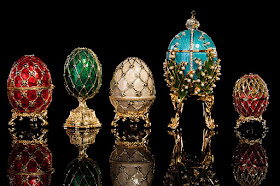One name, one
history…
The story begins in
1842 in St. Petersburg, Russia, where Gustav Faberge a Baltic German jeweller opened
the jewellery firm House of Faberge, which his son, Peter Carl inherited. The
firm has been famous for designing elaborate jewel-encrusted Faberge eggs for
the Russian Tsars and a range of other work of high quality and intricate
details.
The first Faberge egg
was crafted for Tsar Alexander III, who had decided to give his wife, the
Empress Maria Fedorovna, an Easter egg in 1885, possibly to celebrate the 20th
anniversary of their betrothal. Known as the Hen Egg, the first Faberge egg is
crafted from gold. Its opaque white enameled "shell" opens to reveal
its first surprise, a matte yellow-gold yolk. This in turn opens to reveal a
multicolored gold hen that also opens. The hen contained a minute diamond
replica of the imperial crown from which a small ruby pendant was suspended,
but these last two elements have been lost.
 |
| Hen Egg |
Nowadays, you can
admire the world’s largest collection of Faberge eggs in the Faberge Museum located
in the German spa city of Baden-Baden. It was opened on 9 May 2009 by Russian
art collector Alexander Ivanov. Also, the House of Faberge not only creates
luxury eggs but jewellery, timepieces and objects d’art, as well.












No comments:
Post a Comment